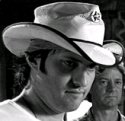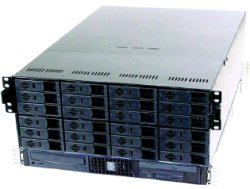Legendary indy director uses Linux to edge out ILM
Mar 25, 2005 — by Henry Kingman — from the LinuxDevices Archive — views [Updated Mar. 29,2005] — A Linux device helped legendary independent filmmaker Robert Rodriguez (El Mariachi, Desperado, Spy Kids, Once Upon a Time in Mexico, and others) win the race with ILM (Industrial Light and Magic) to create the first movie ever to use a digital format supporting full-bandwidth RGB. Rodriguez's Sin City, which opens April 1, was shot in Dual Link, or “4:4:4” format, and transferred between tapes and hard drives using SpectSoft's Linux-based RaveHD DDR (disk drive recorder).
[Updated Mar. 29,2005] — A Linux device helped legendary independent filmmaker Robert Rodriguez (El Mariachi, Desperado, Spy Kids, Once Upon a Time in Mexico, and others) win the race with ILM (Industrial Light and Magic) to create the first movie ever to use a digital format supporting full-bandwidth RGB. Rodriguez's Sin City, which opens April 1, was shot in Dual Link, or “4:4:4” format, and transferred between tapes and hard drives using SpectSoft's Linux-based RaveHD DDR (disk drive recorder).
According to SpectSoft, many high-end movie studios today use Linux for “everything,” from rendering tools to proprietary compositing tools, because of its stability, customizability, and low system overhead. “Linux has won not only renderfarm servers, but the artist desktops of the top studios. It's hard to find a large studio that does not rely upon Linux as its primary animation and special effects OS,” according to a SpectSoft brochure.
SpectSoft's RaveHD adds a high-end video I/O system to the many free and commercial filmmaking packages and products based on Linux. The RaveHD also happens to be one of the first DDRs capable of supporting 4:4:4 RGB video.

The RaveHD is a huge disk array, with a little dual-Xeon system attached
What the heck is “4:4:4 RGB”?
According to Jason Howard, “Cool guy number 6” at Spectsoft, and one of two full-time engineers there, a digital video format supporting full RGB bandwidth has long been a goal of the film industry. “4:4:4 RGB is the thing everyone's been working toward. When ILM (Industrial Light and Magic, LucasFilm's special effects house) put digital filmmaking into motion, or I should say evolution, this is the format that they eventually wanted to work toward. It's ironic that we've beaten them to it.”
Howard is quick to note that ILM is also using Dual Link to make Star Wars Episode III, and also uses Linux-based DDRs. SpectSoft even added features to RaveHD based on feedback from former users of ILM's Linux-based DDRs, he says. But it's Rodriguez, known for making movies Fast, Cheap, and in Control, who will go down in history as the first to get a film into theaters that was captured entirely in 4:4:4 format.
Incidentally, another distinction earned by Rodriguez during the making of Sin City, is that he joined George Lucas and others who have been kicked out of the Director's Guild. Rodriguez's offense, Howard says, was working with a co-director — Sin City comic book creator Frank Miller — who doesn't belong to the Guild.
Lucas, meanwhile, moved to North Marin many years to escape such Hollywood politics, according to Howard. Lucas is currently building a massive million-plus square foot studio over a parking garage in San Francisco's Presidio.
But what about “4:4:4 RGB”?!
Y'CbCr is the color space used by film equipment. Y represents luminance, while Cb and Cr are color difference signals. Consumer DV (digital video) cameras typically use a 4:1:1 Y'CbCr format, in which luminance is sampled for each pixel, while Cb and Cr are sampled at every fourth pixel. SD (standard definition) cameras use a 4:2:2 Y'CbCr format. HD cameras can use 4:2:2, or a 4:2:0 format based on “spatial” samples of 2×2-pixel squares. So 4:4:4, then, is really just RGB, with equal bandwidth for each component color.
“It's really the same as 1:1:1,” explains Howard. “It just means 'take RGB, break it up, send part of it down one wire, and part down the other wire.'”
The compromises in traditional Y'CbCr formats were designed to minimize perceptual loss, keying on the human eye's varying sensitivity to luminescence at various color frequencies. We are most sensitive to brightness in green light, less so in reds, and least with blue. This explains why studios often shoot against a “greenscreen” — Y'CbCr has most information about green, so it's the easiest color for a software program to identify and replace.
In practical terms, Howard says the greater color depth afforded by the Dual Link format gives filmmakers more freedom during “chroma-keying” — the stage at which solid-color filmstudio backdrops are replaced with imagery. “With Sin City, the entire movie was shot on greenscreen. Rodriguez did some work in previous movies with single link (4:2:2 Y'CbCr) video. In a keynote address by Steve Wright that I attended, he mentioned that when he was working at Cinesite LA, they had quite a bit of difficulty getting 'clean' keys with the 4:2:2 source footage from one of Rodriguez's films. This, of course, was in comparison to film. [But] it is harder to get an exact edge with “single link” or 4:2:2 Y'CbCr video. This is due to the fact that the color information is half that of the luma information. Thus, you end up with two pixels that share color information, the effect of which can be minimized by some amount of filtering/scaling for the chroma space.”
The workflow behind Sin City
According to Howard, Troublemaker shot Sin City using two Sony Cinealta F950s. The F950s use HDCAM-SR tape stock. The tapes were “ingested” using a Sony SRW-5000 tape deck connected to the RaveHD box through a dual link SDI (serial digital interface, also known as SMPTE372M) connection, consisting of two HD SDI (SMPTE 292M) cables, each running at 1.485 Gbits/sec, attached to an AJA Xena HD22A SDI card inside the RaveHD.

SpectSoft has written Linux drivers for 14 AJA SDIs, including the Dual Link-capable Kona 2 pictured
(click to enlarge)
During ingestion, the RaveHD wrote sequential DPX files for each shot to a standard Linux JFS filesystem on 2GB fiber disk array, Howard says. When all required shots had been ingested, the entire JFS filesystem was made available via Samba and gigabit Ethernet to the studio's production workers.
The Orphanage also used this same setup for dailies, finals, and to transfer clips from Rave back to HDCAM-SR stock for delivery of shots to Troublemaker, Howard says. “The shots would be rendered into linear 10bit RGB DPX, and transfered to the storage array connected to the RaveHD system. From that point, they would use RaveHD to play back each clip to check it on a calibrated monitor in full RGB gamut. If it made the grade, they would use the RaveHD box to print the frames back to tape (via an insert edit).”
More about the RaveHD
The RaveHD offers three interfaces. An RS-422 port can be used to connect the RaveHD to a front end deck interface device, which can then control it using Sony's P2 protocol. The RaveHD also has a TCP/IP interface that exposes a commandline API. Finally, a cross-platform GUI application written in Qt can run on top of X on the RaveHD itself, or on Windows, Mac, or Linux clients. All interfaces take advantage of an asset management database running on MySQL.
RaveHD's Qt client offers interfaces for previews, dailies, and captures, asset management, light editing, and more. “You aren't going to edit a movie on it, but it does allow you to take a bunch of clips, put the shots back up on tape, build an edit of multiple shots, and put them out on tape,” Howard said.

RaveHD's Qt-based client provides database-backed asset management, using MySQL, as well as light editing features
(Click to enlarge)
The RaveHD is available with a range of drive array options, depending on client needs.
Howard describes the setup used by the Orphanage as follows:
- Supermicro X5DA8 motherboard with dual 2.5GHz Xeon processors running a Linux 2.4.10 kernel
- Two 2Gbit fiber channel controllers
- 16-disk fiber channel array (eight disks per fiber) in software RAID 0, with a JFS filesystem
- AJA Xena HD22 (Dual Link) SDI (serial digital interface) board using Linux drivers written by SpectSoft
- Antona RS-232 to RS-422 converter for machine control using Sony's P2 deck control protocol
According to Howard, work on the visual effects in Sin City has been going on for about a year.
What's next for SpectSoft?
Shortly after Sin City opens, SpectSoft will launch a new model of the RaveHD DDR. The $25,000 RaveHD Xenon comes with 6TB to 9.6TB of local SATA storage — enough for several hours of Dual Link video, Howard says. Naturally, it runs Linux. The Xenon model will debut at the NAB (National Association of Broadcasters) trade show, set for Apr. 16-21, in Las Vegas.
According to Howard, other RaveHD customers include Turner Studios-Atlanta, Blue Sky Studios-NY, Custom Film Effects-Burbank, and Tippett Studios, in Oakland. However, he adds, “The Orphanage is our first customer to use Dual Link I/O — so it was certainly a learning experience for both of us.”
This story was updated on Mar. 29 to correct erroneous facts.
This article was originally published on LinuxDevices.com and has been donated to the open source community by QuinStreet Inc. Please visit LinuxToday.com for up-to-date news and articles about Linux and open source.